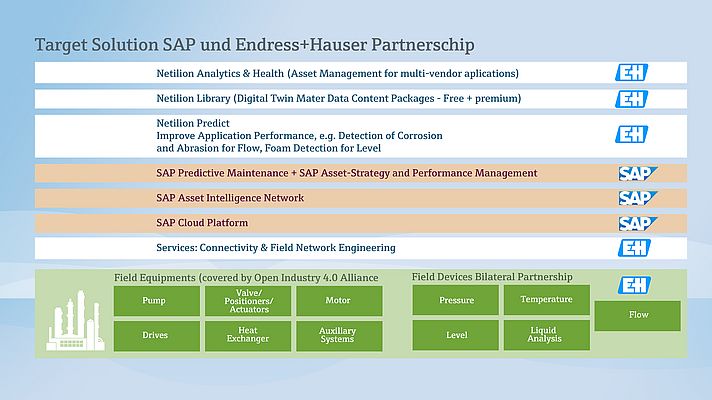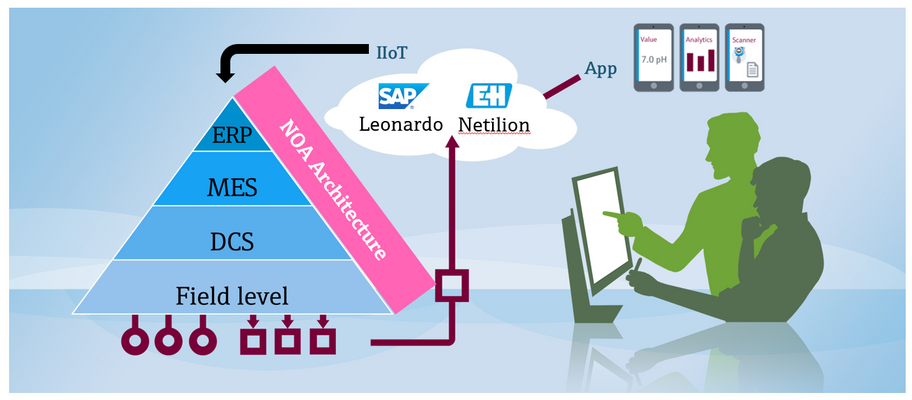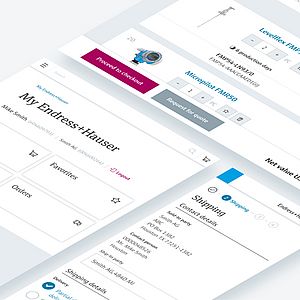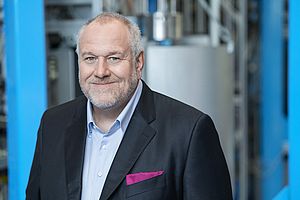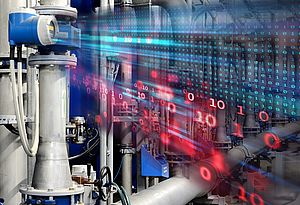Although the world is becoming increasingly connected, an insular mindset still dominates in much of the process control industry. There are good reasons for decoupling process control technology at the operational technology (OT) level from the enterprise IT level, such as ensuring that the availability and safety of process control systems is not at risk. In the digital age, however, this demarcation appears to be obsolete.
“The vast majority of our field instruments are already digital, and we want to release this potential,” emphasizes Endress+Hauser CEO Matthias Altendorf. As before, the only information that is captured in many process control systems is the measurement values, not the wealth of other parameters that a digital measurement instrument also supplies, which can then provide information regarding the state of the instrument and the process. “Only 3 percent of the data that our installed base of 40 million instruments supplies is actually utilized. A lot of opportunities for optimization are therefore wasted,” says Altendorf.
Endress+Hauser and SAP share the conviction that coupling the OT and IT levels opens up significant opportunities for operational optimization and efficiency improvements. In concrete terms, that means taking the data at the OT level, which is contained in a closed system without internet connectivity and making it available to the company. In fact, 90 percent of the Endress+Hauser installed base already features a common fieldbus interface, making it possible to read out this information. The only thing missing is a permanent connection to the “upper level” so that this information can be analyzed and utilized for business, logistical and production-related enterprise processes.
Second data path to the IIoT
To avoid having to modify the established systems and flows within the process control technology, the simplest way to connect the levels is through the creation of a “second data path”. Relying on suitable interface modules at the field level (edge devices), the data from the digital measurement instruments is transmitted directly to a cloud platform, without diverting it to the process control system (the so-called Industrial Internet of Things or IIoT approach). The field instruments reside in the cloud in the form of “digital twins”. In contrast to the actual instruments, with little effort these digital twins are accessible at any time and from anywhere and are available for algorithm-based analyses and digital applications (apps).
Endress+Hauser already provides its customers with several of these types of apps through the Netilion IIoT ecosystem. The underlying application, Netilion Analytics, enables the (manufacturer-independent) cataloging of all field instruments in a system. Each field instrument in the system has a digital twin residing in Netilion. The information that is read out from the instruments is coupled with the supplementary data from the manufacturer’s instrument database using the Netilion Library. By itself, the Endress+Hauser database contains more than 40 million datasets.
Calibration certificates or repair reports, as well as information related to critical measurement points, are also directly available via the digital twins. When it comes to maintenance or engineering activities, this saves valuable time since the often time-consuming search for information is eliminated.
Direct link between production and operational processes
In a next step, the data stored in the digital twin is made available for the business processes across the company. If the digital twin indicates that maintenance is due, for example, the corresponding SAP notification, such as ordering a maintenance engineer or spare parts, can be created immediately. End-to-end communication, from the field to the SAP system, is realized by coupling the Netilion applications with the SAP Asset Intelligence Network. The latter is a collaboration network for the manufacturing industry, which is used to exchange digital twins between instrument manufacturers, plant operators and engineering service providers.
Through the intelligent integration of the previously isolated applications, the field instrument data can now be used directly for the quality assurance and maintenance processes within the company. Seamlessly integrating the operational data from the production system into the business processes makes it possible to make faster and better-quality decisions, which ultimately drives down operational costs and optimizes processes.
With the help of Heartbeat technology integrated in Endress+Hauser flowmeters, for instance, corrosion and abrasion in the piping can be detected and corresponding measures directly coordinated with the maintenance plan stored in the SAP system if required. Another major advantage, especially for plant operators who normally rely on field instruments and automation components from various manufacturers, is the manufacturer-independent SAP Asset Intelligence Network, which can offer customers further applications from SAP and third-party manufacturers.
Last but not least, this shared platform brings the manufacturer and plant operator perspectives closer together. Operators gain access to the manufacturer’s know-how. In turn, manufacturers learn first-hand which utilization profiles or problems occur at the customer, thus allowing them to take these issues into account if a product is slated to undergo a redesign. This leads to the creation of “digital chains” that link the engineering, operations, service and decommissioning areas beyond the boundaries of the enterprise. SAP and Endress+Hauser want to join forces to co-develop integrated solutions and thus offer their customers a new and innovative set of services.
From partnership to industry alliance
The core of the partnership between SAP and Endress+Hauser is the implementation of the end-to-end communications capability between the field and operational levels, plus the development of the applications based on these infrastructures.
“Since a large number of our customers work with SAP software, this type of cooperation made a lot of sense for us,” says Endress+Hauser CEO Matthias Altendorf in explaining the motivation behind the project. Christian Klein, member of the board at SAP, is of the same opinion. “This partnership is extremely valuable for us as well. It creates a tremendous opportunity for our customers to save costs in the areas of maintenance and quality management and to design more efficient processes.”
By Hans Huber, General Manager IIoT at Endress+Hauser Process Solutions GmbH and Timothy Kaufmann, Head of Business Development IoT MEE at SAP Germany


